Tenerife is a paradise for foodies. These dishes are not to be missed.
16 Nov 2022
Tenerife boasts a unique cuisine. You don't have to look far for the reason; a glance at the map will suffice. The Canary Islands lie between three continents, so different influences converge here. Tenerife's cuisine is, almost literally, a melting pot of aromas and flavors.
Thus, the archipelago played a key role in trade between Europe, Africa and the New World. Tenerife and other islands were a final stop before crossing the Atlantic. Conversely, potatoes, tomatoes, corn, as well as avocados and papayas arrived from America. From Asia, mangoes followed. Arabic influences mean that Canarian cooks use more spices like cumin, paprika and dried chili than their counterparts on the Spanish mainland. And to the original inhabitants of the islands, the Guanches, we owe gofio, a flour made from roasted grains.
[caption id="attachment_165456" align="aligncenter" width="1024"]
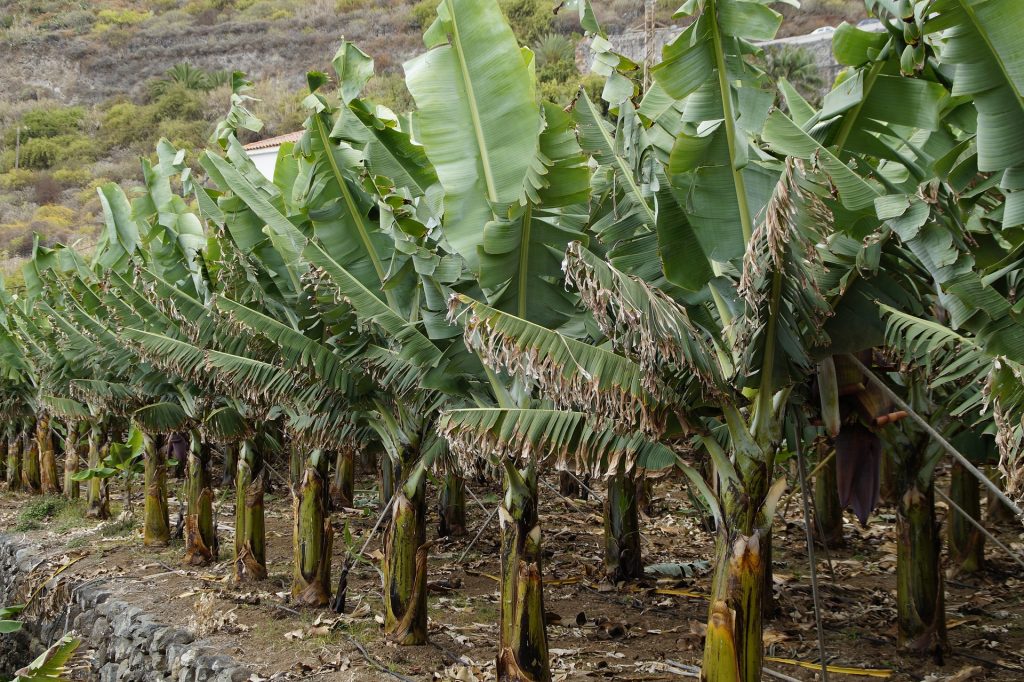
Bananas: the main crop in Tenerife.[/caption]
Its location and geography provides other advantages. Tenerife is surrounded by the sea, which provides an abundance of fish and shellfish. Blessed with fertile volcanic soil - chock-full of minerals - that ensures that bananas, mangoes, avocados and tomatoes of towering quality grow here. In addition, the inhabitants of the Canary Islands are real meat eaters. There is little room for cows to graze, so beef is usually imported. Instead, be sure to try the locally raised meats: pig, rabbit and especially goat.
Even within the archipelago, each Canary Island places its own emphases. With dishes you can only eat there. The cuisine is all about simple, fresh ingredients and not too much fuss. Grilled fish with a fresh herb sauce, boiled potatoes, juicy goat meat, simple tomato slices with olive oil sprinkled on top, fresh fruit: pure flavors that prove that delicious doesn't have to be complicated. And even though you can find equally Spanish classics like paella, tortilla and gazpacho here, it would be a shame to ignore the unique Canarian cuisine.
[caption id="attachment_165452" align="aligncenter" width="1024"]
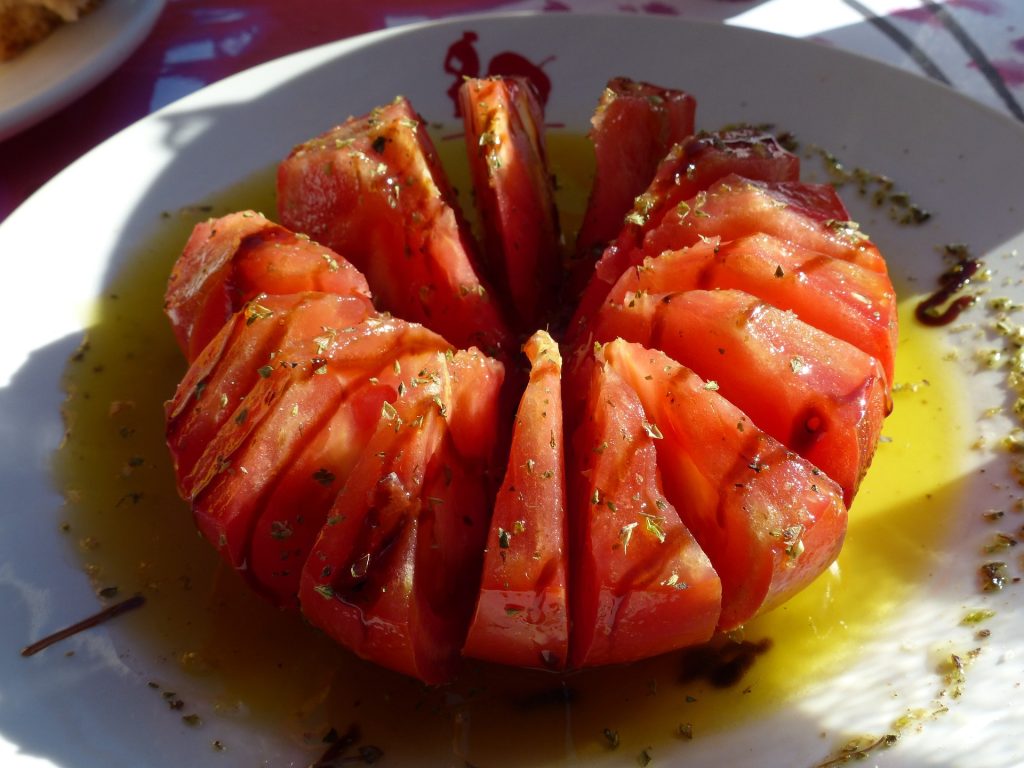
Tomato with olive oil: simple, but delicious.[/caption]
Breakfast
Gofio
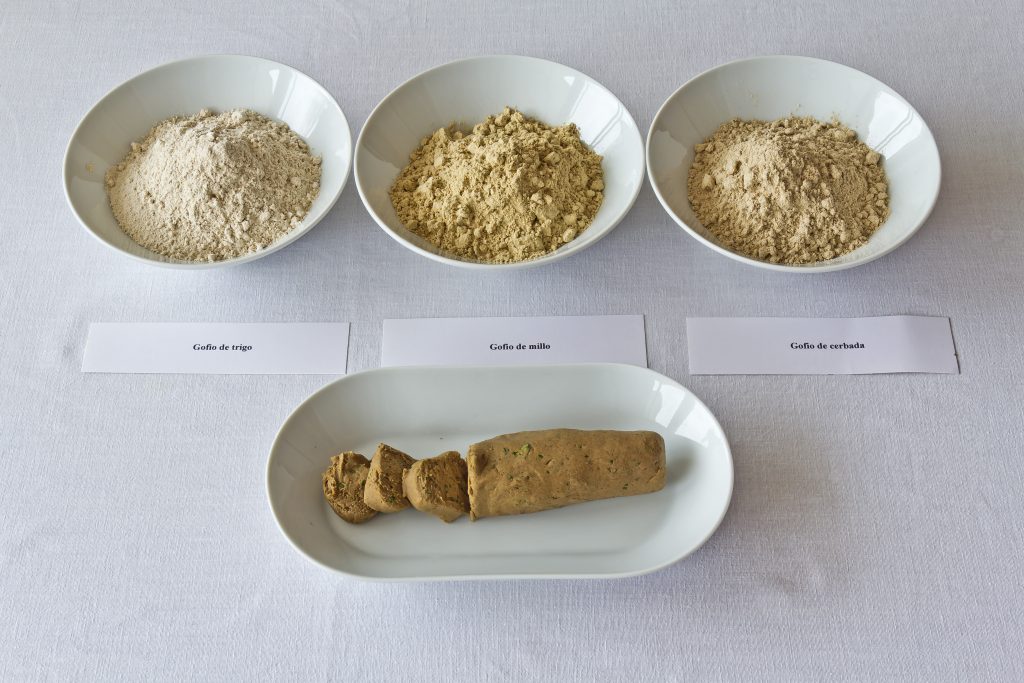
The most tangible remnant of the Guanches, the original inhabitants of the Canary Islands. Gofio is a flour made from roasted grains such as corn and barley. Feel free to consider it a superfood, packed with fiber, vitamins and minerals. Traditionally, people in Tenerife ate this in poor times, when not much else was available. Now you often find it in the breakfast buffet - to sprinkle over your yogurt or mix with milk.
Hence, we catalog it under breakfast. But really, the possibilities are endless. In fact, this flour can be added almost anywhere.
Escaladon de gofio
Is scalded gofio mixed with fish broth and cilantro sauce, delicious as an appetizer on bread. Gofio can also join the typical
stew
puchero.
And often forms the basis for sweets - from gofio cookies to ice cream or mousse, from bananas with gofio to liqueur.
Appetizers or side dishes
Papas arrugadas
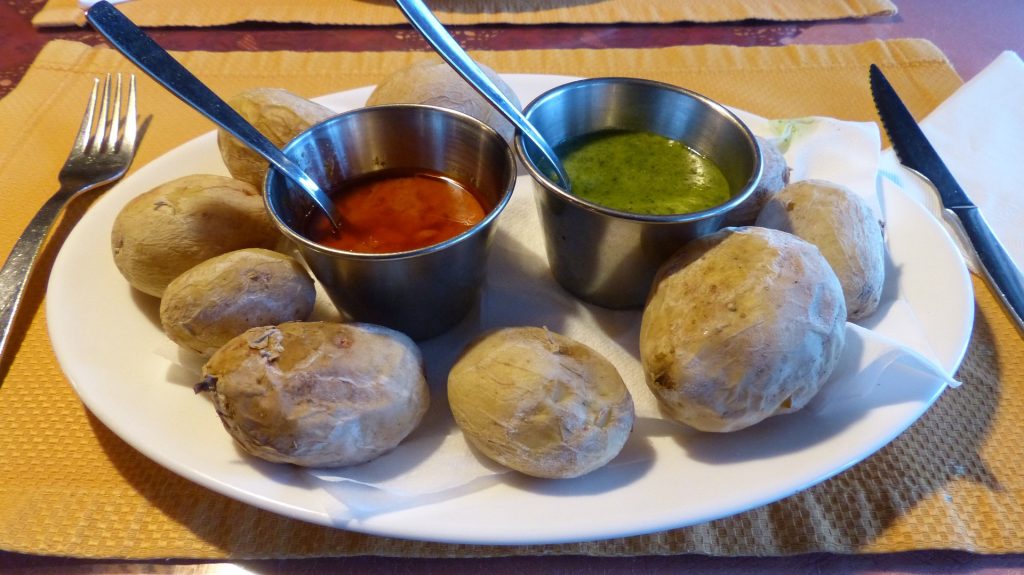
Alias: wrinkled potatoes. This dish fits Tenerife like French fries fit Belgium or fish & chips fit the United Kingdom, the primal classic that everyone loves. The secret: potatoes are boiled in their skins in firmly salted water - traditionally even in sea water. This gives them a wonderfully wrinkled salt skin. Perfect as a snack on a hot day with a cool beer or glass of white wine, but equally delicious with mojo (see below) with meat and fish.
Take advantage of it when you're in Tenerife, because nowhere taste
papas arrugades
as intense as here. Here's the thing: explorers and traders introduced potatoes to the Canary Islands very early on, in the early 16th century. The potatoes growing in Tenerife in 2022 are descended from those very first varieties. Hence their nickname,
papas antiguas
or old potatoes. Their limited size, not much bigger than a golf ball, is also related to this. On top of that, in Tenerife they grow in rich, volcanic soil, which provides extra flavor.
Mojo
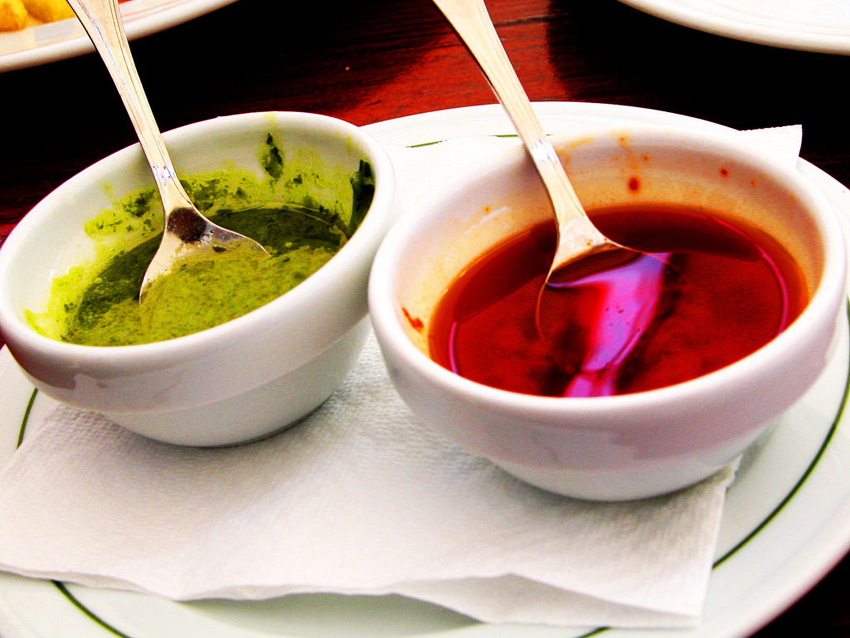
From chicken drumsticks to potatoes to cheese: there is no dish or a
tinerfeño
quacks mojo on it. Mojo is a spicy sauce that can be made in several ways. There is
mojo picón
, the spiciest version of vinegar, olive oil, red peppers, cayenne pepper, garlic and salt.
Mojo rojo
(red mojo) is similar, but often contains crumbled bread to thicken the sauce.
Mojo verde
(green mojo) has cilantro and/or parsley as the main ingredient,
mojo negro
(black mojo) does it with black garlic. So those who think they have lost their mojo can find it again in Tenerife.
Queso de la plancha
Reportedly, residents of the Canary Islands eat more cheese per person than those of any other region of Spain. Throughout the archipelago, family farms still produce the cheese in the traditional way. Tenerife alone produces 75 different cheeses, but enthusiasts can also indulge in the other Canary Islands. From
majorero
on Fuerteventura to salty
palmero
on La Palma: there are a lot of goodies to pick up.
Goat cheese in particular is found everywhere and in every possible way.
Fresco
is perhaps the most popular, a freshly made cheese that keeps for only a few days. But also salted or smoked (usually from the remote Anaga Mountains), deep-fried (
queso asado
) or with peppers or gofio are among the possibilities.
[caption id="attachment_165444" align="aligncenter" width="922"]
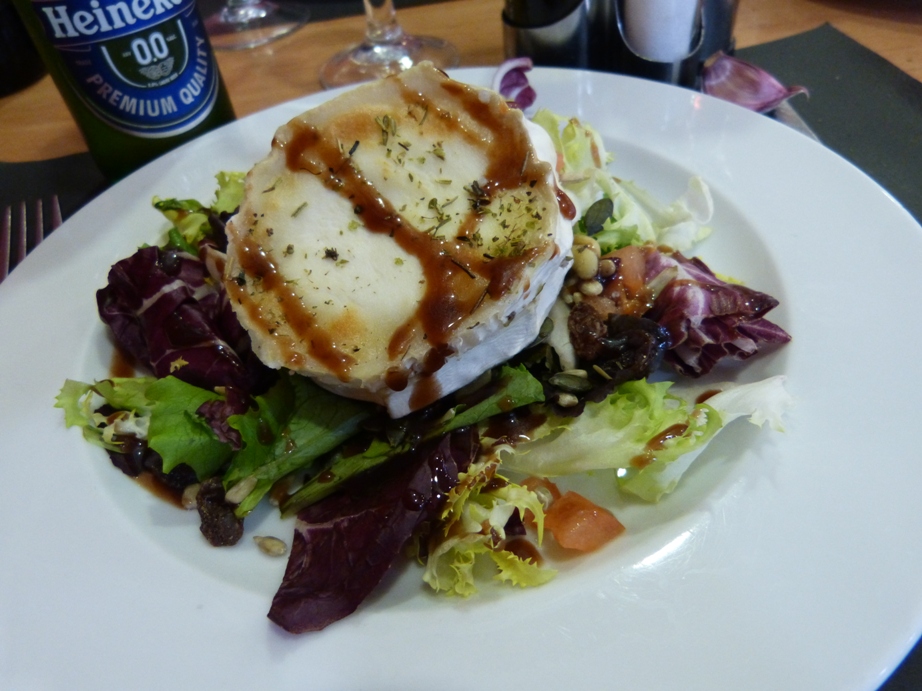
Or, as here, with a salad.[/caption]
Who dots here
queso a la plancha
to, grilled cheese. In this case, the cook will first bread the goat cheese, then deep fry or bake it and serve it with a honey, red or green mojo. Often you get a shelf with all three. The sweetness of honey offsets the smoky flavor of the cheese - very nice with wine!
Almogrote
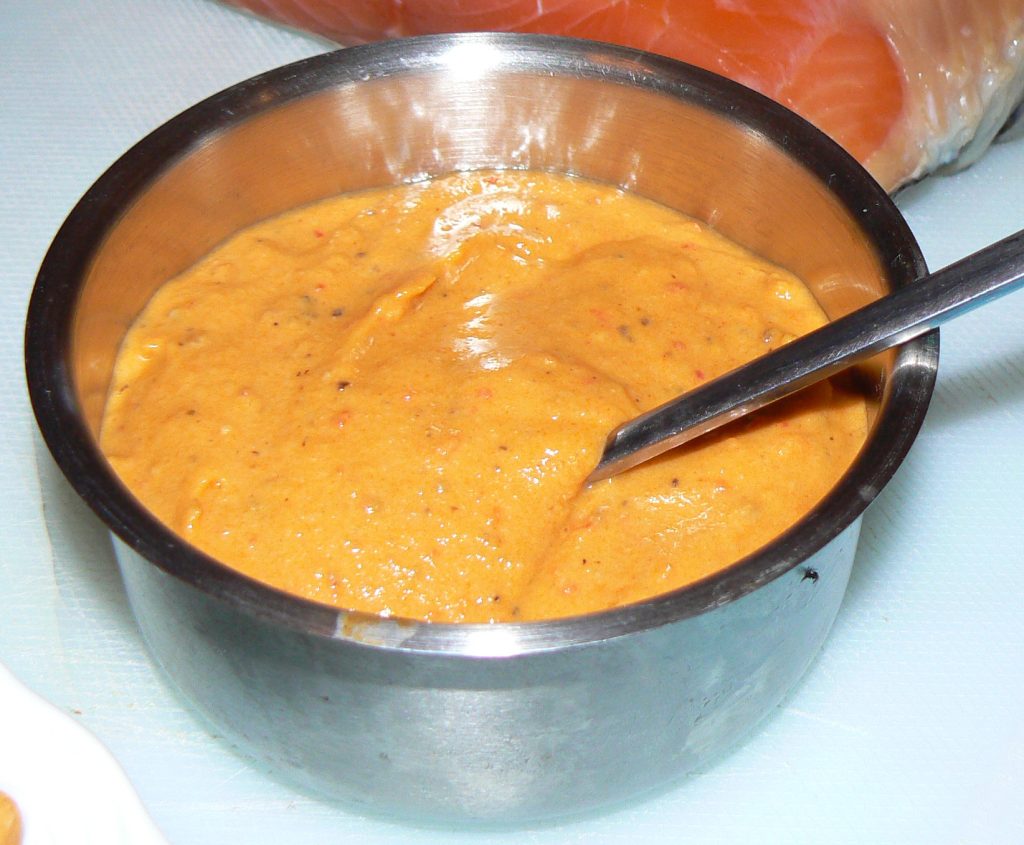
A variation on mojo from neighboring island La Gomera, a cheese spread made from tomatoes, garlic, olive oil and hard goat cheese. Most versions contain paprika (red), others cilantro (green). You can spread it on (toasted) bread or with meat or
papas arrugadas
food.
And further:
-
Croquetas
. All over Spain you will find these fried balls, usually stuffed with potatoes and jamón. It is one of the most beloved tapas for good reason. The addition
caseras
means they were prepared in house.
- Arvejas con huevo duro.Peas cooked in a broth of tomatoes and onion, served with a shredded hard-boiled egg, crispy bread crumbs and (sometimes) ham. Popular appetizer.
- Like fish, squid appears regularly on menus in Tenerife. The Canarian answer to calamari called
chopitos -
small breaded and deep-fried squid, crispy and perfect as a snack with mojo.
Calamares rellenos
Is squid stuffed with meat. Octopus is called here
pulpo
, usually boiled and served with olive oil or grilled and accompanied by a sauce of tomatoes and onion.
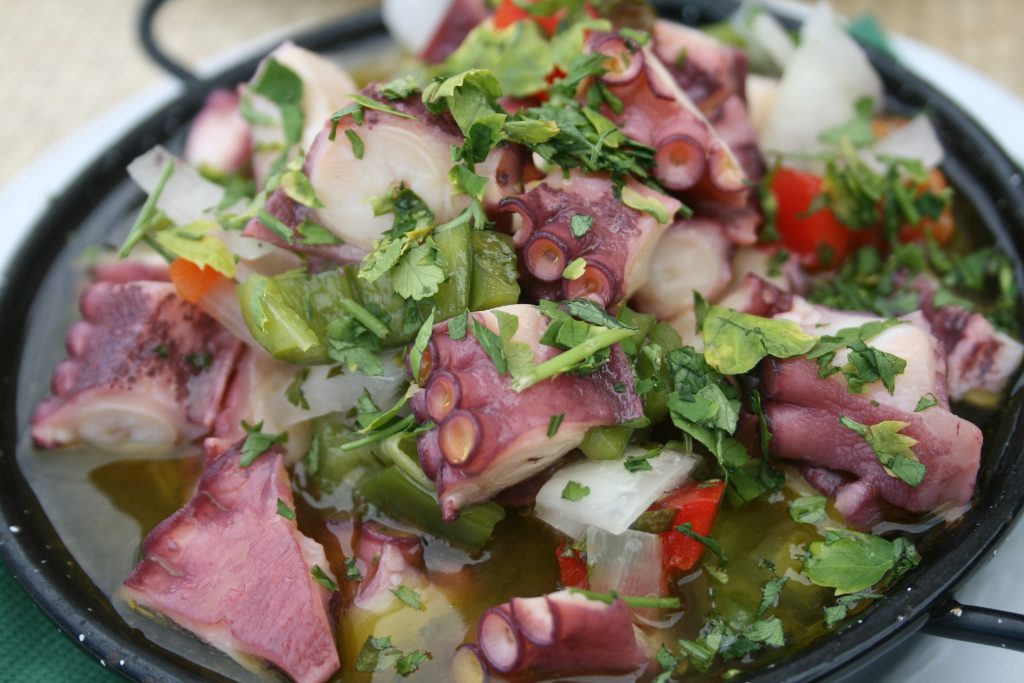
Main courses
Ropa vieja
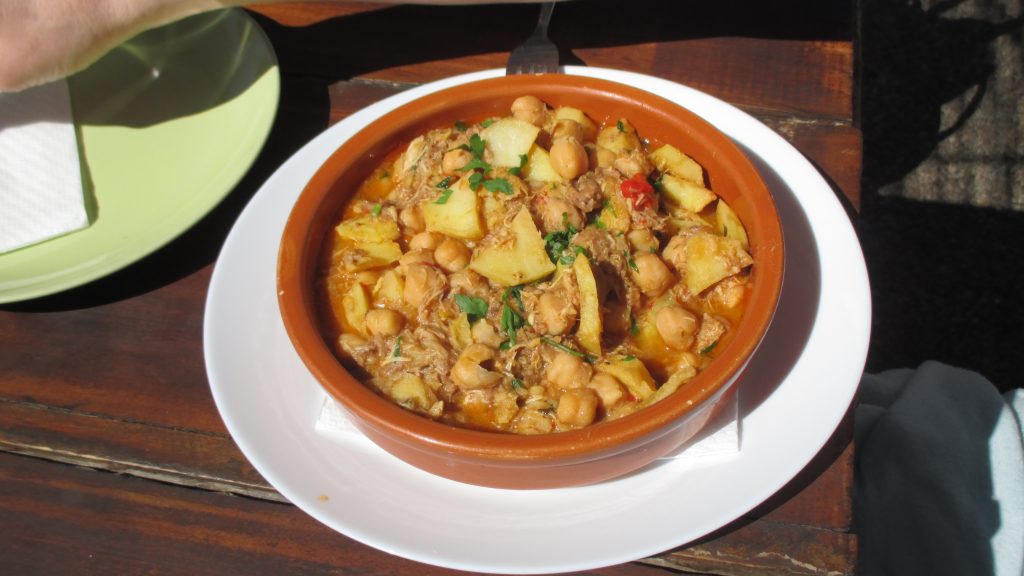
The literal translation, "old clothes," does not sound particularly appetizing. But trust us: this savory stew of shredded beef, chicken and other meat scraps, chickpeas and tomatoes is a true flavor bomb. Courtesy of a handful of herbs and a dash of vinegar.
Fun fact to unwrap at the table:
ropa vieja
is also the national dish of Cuba. Canarian sailors and adventurers brought it home. For that reason, it is also more popular in Gran Canaria, the island most inspired by Cuban cuisine. Tenerife adopted more influences from Venezuela. In the
ropa vieja
Tenerife, chickpeas occupy an important place.
Sancocho
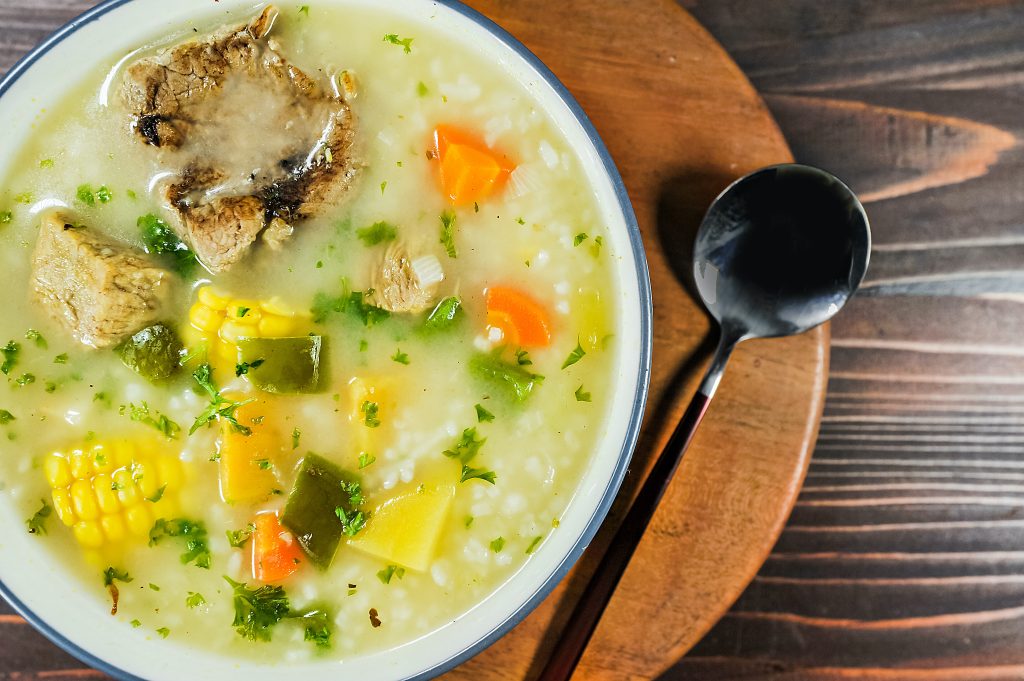
Fresh fish is a crucial part of the diet, we said. Among others, sea bass, mackerel, sardines, pollock and parrotfish are regularly on the menu - fried, steamed or stewed, grilled whole, as tartare or in ceviche. The locals are also enamored with
atún and adobo
, marinated tuna. Sancocho is possibly Tenerife's most iconic fish dish, a stew or thick soup of white fish (usually wreck or sea bass) with sweet potatoes, olive oil and a generous helping of parsley. Served, of course, with mojo and gofio.
Cochino negro
Meat from a Canarian black pig, a special breed with protected status that only a few breeders are allowed to keep. As a result, it is not easy to find. Only a few restaurants serve it, others put it on the menu but not always
the real deal
. The best cooks cook it slowly over an open flame until it is tender and juicy.
And further:
-
Carne con papas
. Literally: meat with potatoes, usually in a sauce of tomatoes, onion, garlic, vegetables and white wine. Delicious in all its simplicity.
-
Conejo al salmorejo.
Rabbit marinated and simmered in white or red wine sauce, flavored with tomato, bell bell pepper, garlic and onion.
Pollo al salmorejo.
Also exists: chicken with the same sauce.
[caption id="attachment_165424" align="aligncenter" width="1024"]
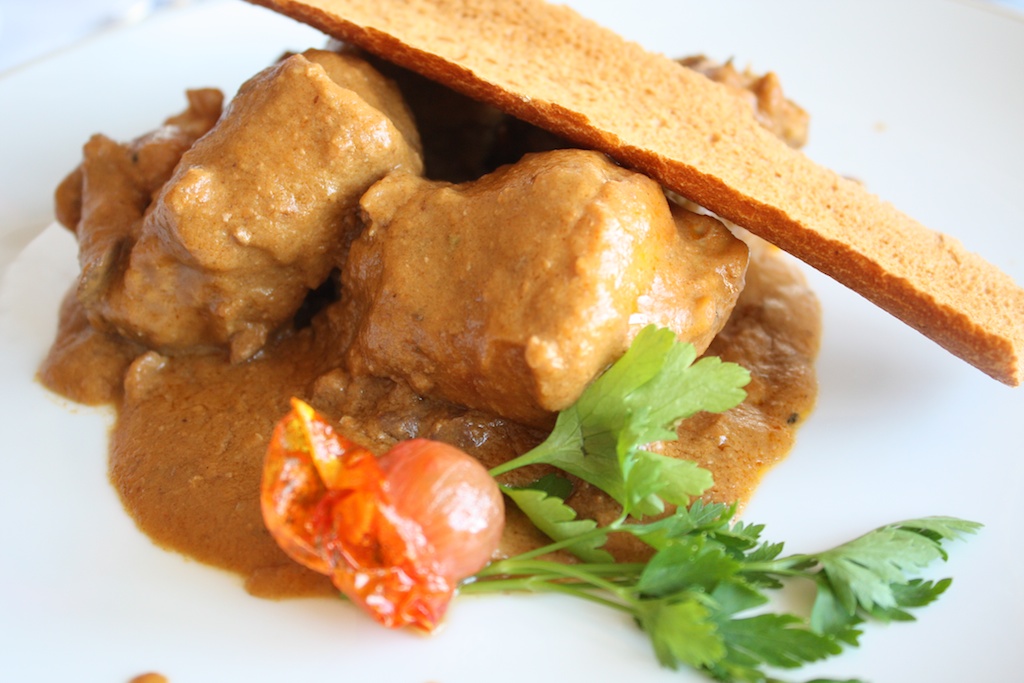
Conejo al salmorejo.[/caption]
-
Carne de cabra
. Goat meat - often in a stew, sometimes grilled.
-
Arroz a la Cubana
. A dish often found on the table in Canarian households: fried eggs, rice, meat and fried bananas. Bananas are Tenerife's most important crop for a reason. Fun fact: in Cuba, no cat knows this rice Cuban style.
-
Huevos estampidos
. This spiegeleiren with potatoes and sausage is on menus all over Spain. In Tenerife, cooks work in layers: eggs, Canarian
morcilla
(blood sausage) and fried potatoes.
-
Potaje de berros
. Watercress soup, one of the many soups eaten in the Canary Islands.
-
Rancho canario
. Savory broth with thick noodles, pieces of meat and potatoes.
-
Puchero
. A stew from grandmother's kitchen, made with organ and other waste meat, corn cobs, cabbage and other vegetables.
[caption id="attachment_165428" align="aligncenter" width="1024"]
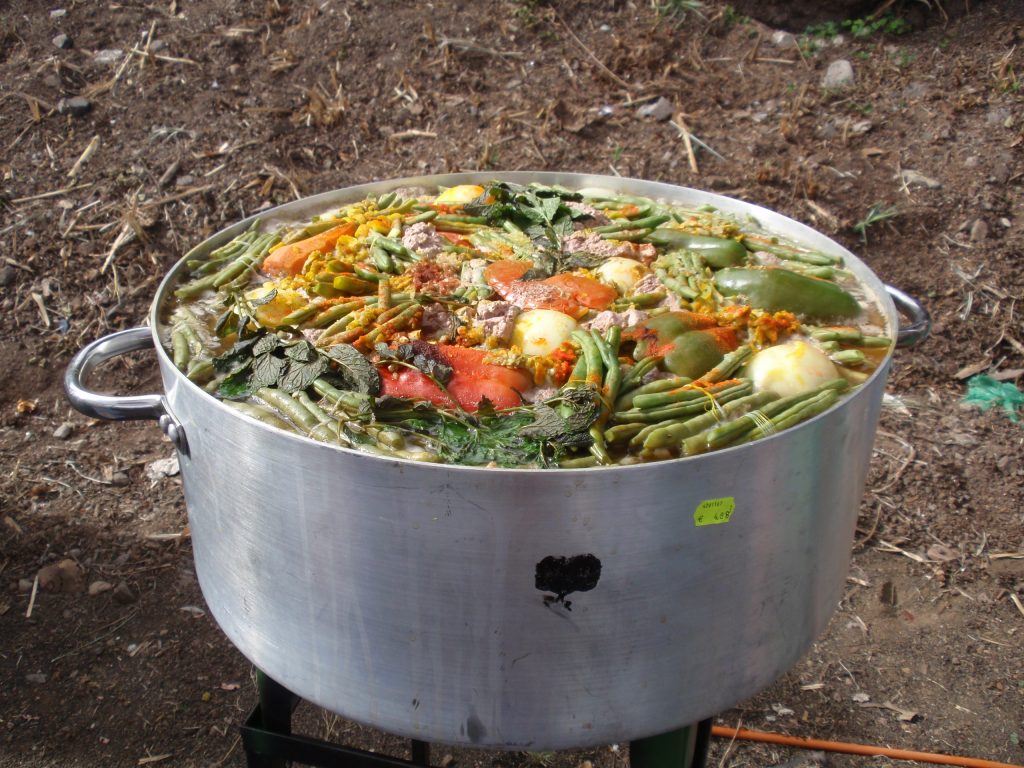
Puchero.[/caption]
For vegetarians and vegans
Tenerife is not the easiest destination for those who do not eat animal products, although there are moves here and there. On most menus, vegetarians can find a selection of salads, as well as
champiñones
(mushrooms, often lightly fried in olive oil and garlic),
bear coat
(eggplants),
papas
(potatoes),
menestra
(savory vegetable stew) and
pimientos de padrón (grilled green peppers with salt).
[caption id="attachment_165420" align="aligncenter" width="1024"]
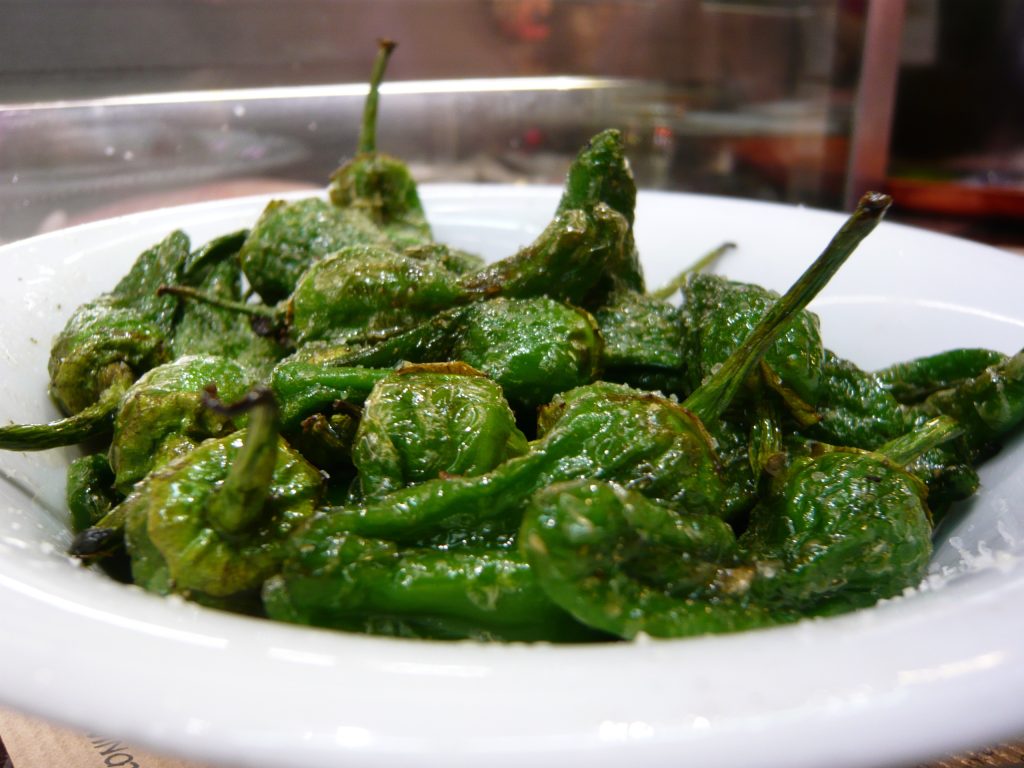
Piementos de Padrón: one of the options for vegetarians and vegans.[/caption]
Desserts/sweets
Canary Islanders have a real sweet tooth. Among other things, they snack on
bienmesabe
(a thick, sticky and sugary goo of almonds, egg yolks, cinnamon and sugar),
frangollo
(a mixture of cornmeal, milk and honey),
bizcochos lustrados
(sponge cake) and
truchas de batata
(literally: packets of sweet potato).
The delicacies of other islands are also often found in Tenerife, such as
rapadura
from La Palma
(cone-shaped confectionery, with gofio, honey, eggs and a flavoring such as chocolate, coconut or almonds) and quesadillas from El Hierro (cheesy cinnamon patties, often with anise seeds).
Morcillas dulces (
sweet puddings) include grapes, raisins and almonds.
Beverages
Vino
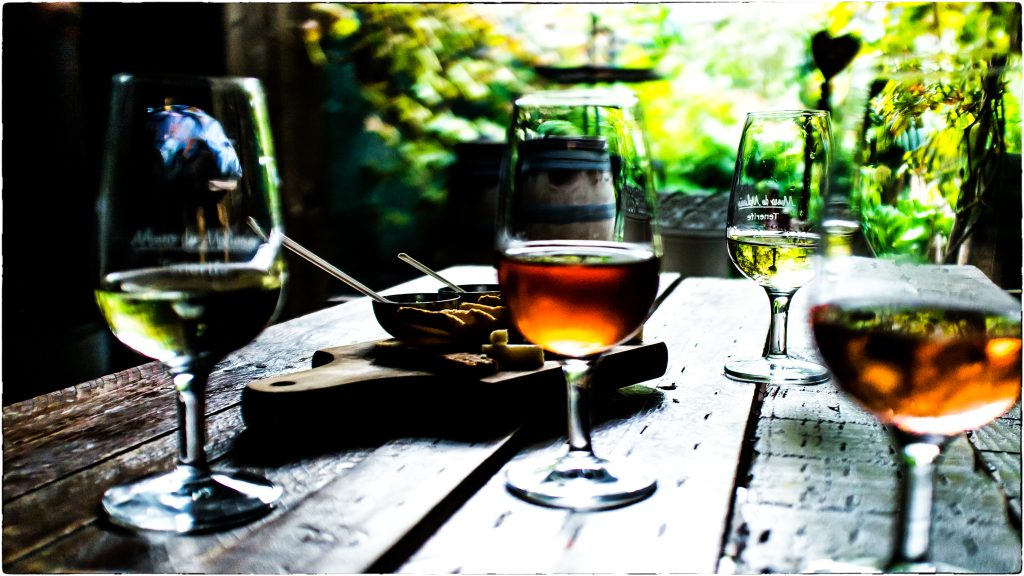
The mineral-rich soil, fed by volcanic ash and lava, lends itself well to grape growing. The trade winds add a salty touch. That led to a multitude of wineries, some centuries old, and a wide variety of grapes. Especially in the north of the island, around Tacoronte, La Orotava, Icod de los Vinos, a lot of goodies ripen in the vineyards. Tenerife is considered the leading wine producer in the Canary Islands - its dry, acidic white wines and smooth reds are especially renowned. The red Tacaronte Acentejo was the first to receive a
denominación de origin
, a label indicating high quality. Meanwhile, five wines received that recognition.
Cerveza
In Santa Cruz de Tenerife, Dorada, the most popular local lager, is brewed. You can drink that as
caña
or
jarra
, respectively, a small or large beer from the barrel.
Cafe
Coffee farmers grow the black gold in the Canary Islands themselves, especially in the Agaete Valley in northern Gran Canaria. These are the different options for ordering your coffee:
- Café con leche: 50 percent coffee, 50 percent milk.
- Sombra: ditto, but more milk.
- Café solo: small black coffee or espresso.
- Cortado: espresso with a touch of milk.
- Cortado de leche y leche: espresso with condensed or plain milk.
- Barraquito: larger version of cortado.
- Café con hielo: glass with ice and a coffee to cut over it.
Licores
From neighboring island of La Gomera comes
mistela
, a mixture of wine, sugar, spices and
parra
(a type of grappa). Rum is also made locally, often served as a
chupito
(shot) after a meal or with honey.
Buen provecho!
 Bananas: the main crop in Tenerife.[/caption]
Its location and geography provides other advantages. Tenerife is surrounded by the sea, which provides an abundance of fish and shellfish. Blessed with fertile volcanic soil - chock-full of minerals - that ensures that bananas, mangoes, avocados and tomatoes of towering quality grow here. In addition, the inhabitants of the Canary Islands are real meat eaters. There is little room for cows to graze, so beef is usually imported. Instead, be sure to try the locally raised meats: pig, rabbit and especially goat.
Even within the archipelago, each Canary Island places its own emphases. With dishes you can only eat there. The cuisine is all about simple, fresh ingredients and not too much fuss. Grilled fish with a fresh herb sauce, boiled potatoes, juicy goat meat, simple tomato slices with olive oil sprinkled on top, fresh fruit: pure flavors that prove that delicious doesn't have to be complicated. And even though you can find equally Spanish classics like paella, tortilla and gazpacho here, it would be a shame to ignore the unique Canarian cuisine.
[caption id="attachment_165452" align="aligncenter" width="1024"]
Bananas: the main crop in Tenerife.[/caption]
Its location and geography provides other advantages. Tenerife is surrounded by the sea, which provides an abundance of fish and shellfish. Blessed with fertile volcanic soil - chock-full of minerals - that ensures that bananas, mangoes, avocados and tomatoes of towering quality grow here. In addition, the inhabitants of the Canary Islands are real meat eaters. There is little room for cows to graze, so beef is usually imported. Instead, be sure to try the locally raised meats: pig, rabbit and especially goat.
Even within the archipelago, each Canary Island places its own emphases. With dishes you can only eat there. The cuisine is all about simple, fresh ingredients and not too much fuss. Grilled fish with a fresh herb sauce, boiled potatoes, juicy goat meat, simple tomato slices with olive oil sprinkled on top, fresh fruit: pure flavors that prove that delicious doesn't have to be complicated. And even though you can find equally Spanish classics like paella, tortilla and gazpacho here, it would be a shame to ignore the unique Canarian cuisine.
[caption id="attachment_165452" align="aligncenter" width="1024"] Tomato with olive oil: simple, but delicious.[/caption]
Tomato with olive oil: simple, but delicious.[/caption]
 The most tangible remnant of the Guanches, the original inhabitants of the Canary Islands. Gofio is a flour made from roasted grains such as corn and barley. Feel free to consider it a superfood, packed with fiber, vitamins and minerals. Traditionally, people in Tenerife ate this in poor times, when not much else was available. Now you often find it in the breakfast buffet - to sprinkle over your yogurt or mix with milk.
Hence, we catalog it under breakfast. But really, the possibilities are endless. In fact, this flour can be added almost anywhere.
Escaladon de gofio
Is scalded gofio mixed with fish broth and cilantro sauce, delicious as an appetizer on bread. Gofio can also join the typical stew
puchero.
And often forms the basis for sweets - from gofio cookies to ice cream or mousse, from bananas with gofio to liqueur.
The most tangible remnant of the Guanches, the original inhabitants of the Canary Islands. Gofio is a flour made from roasted grains such as corn and barley. Feel free to consider it a superfood, packed with fiber, vitamins and minerals. Traditionally, people in Tenerife ate this in poor times, when not much else was available. Now you often find it in the breakfast buffet - to sprinkle over your yogurt or mix with milk.
Hence, we catalog it under breakfast. But really, the possibilities are endless. In fact, this flour can be added almost anywhere.
Escaladon de gofio
Is scalded gofio mixed with fish broth and cilantro sauce, delicious as an appetizer on bread. Gofio can also join the typical stew
puchero.
And often forms the basis for sweets - from gofio cookies to ice cream or mousse, from bananas with gofio to liqueur.
 Alias: wrinkled potatoes. This dish fits Tenerife like French fries fit Belgium or fish & chips fit the United Kingdom, the primal classic that everyone loves. The secret: potatoes are boiled in their skins in firmly salted water - traditionally even in sea water. This gives them a wonderfully wrinkled salt skin. Perfect as a snack on a hot day with a cool beer or glass of white wine, but equally delicious with mojo (see below) with meat and fish.
Take advantage of it when you're in Tenerife, because nowhere taste
papas arrugades
as intense as here. Here's the thing: explorers and traders introduced potatoes to the Canary Islands very early on, in the early 16th century. The potatoes growing in Tenerife in 2022 are descended from those very first varieties. Hence their nickname,
papas antiguas
or old potatoes. Their limited size, not much bigger than a golf ball, is also related to this. On top of that, in Tenerife they grow in rich, volcanic soil, which provides extra flavor.
Alias: wrinkled potatoes. This dish fits Tenerife like French fries fit Belgium or fish & chips fit the United Kingdom, the primal classic that everyone loves. The secret: potatoes are boiled in their skins in firmly salted water - traditionally even in sea water. This gives them a wonderfully wrinkled salt skin. Perfect as a snack on a hot day with a cool beer or glass of white wine, but equally delicious with mojo (see below) with meat and fish.
Take advantage of it when you're in Tenerife, because nowhere taste
papas arrugades
as intense as here. Here's the thing: explorers and traders introduced potatoes to the Canary Islands very early on, in the early 16th century. The potatoes growing in Tenerife in 2022 are descended from those very first varieties. Hence their nickname,
papas antiguas
or old potatoes. Their limited size, not much bigger than a golf ball, is also related to this. On top of that, in Tenerife they grow in rich, volcanic soil, which provides extra flavor.
 From chicken drumsticks to potatoes to cheese: there is no dish or a
tinerfeño
quacks mojo on it. Mojo is a spicy sauce that can be made in several ways. There is
mojo picón
, the spiciest version of vinegar, olive oil, red peppers, cayenne pepper, garlic and salt.
Mojo rojo
(red mojo) is similar, but often contains crumbled bread to thicken the sauce.
Mojo verde
(green mojo) has cilantro and/or parsley as the main ingredient,
mojo negro
(black mojo) does it with black garlic. So those who think they have lost their mojo can find it again in Tenerife.
From chicken drumsticks to potatoes to cheese: there is no dish or a
tinerfeño
quacks mojo on it. Mojo is a spicy sauce that can be made in several ways. There is
mojo picón
, the spiciest version of vinegar, olive oil, red peppers, cayenne pepper, garlic and salt.
Mojo rojo
(red mojo) is similar, but often contains crumbled bread to thicken the sauce.
Mojo verde
(green mojo) has cilantro and/or parsley as the main ingredient,
mojo negro
(black mojo) does it with black garlic. So those who think they have lost their mojo can find it again in Tenerife.
 Or, as here, with a salad.[/caption]
Who dots here
queso a la plancha
to, grilled cheese. In this case, the cook will first bread the goat cheese, then deep fry or bake it and serve it with a honey, red or green mojo. Often you get a shelf with all three. The sweetness of honey offsets the smoky flavor of the cheese - very nice with wine!
Or, as here, with a salad.[/caption]
Who dots here
queso a la plancha
to, grilled cheese. In this case, the cook will first bread the goat cheese, then deep fry or bake it and serve it with a honey, red or green mojo. Often you get a shelf with all three. The sweetness of honey offsets the smoky flavor of the cheese - very nice with wine!
 A variation on mojo from neighboring island La Gomera, a cheese spread made from tomatoes, garlic, olive oil and hard goat cheese. Most versions contain paprika (red), others cilantro (green). You can spread it on (toasted) bread or with meat or
papas arrugadas
food.
A variation on mojo from neighboring island La Gomera, a cheese spread made from tomatoes, garlic, olive oil and hard goat cheese. Most versions contain paprika (red), others cilantro (green). You can spread it on (toasted) bread or with meat or
papas arrugadas
food.

 The literal translation, "old clothes," does not sound particularly appetizing. But trust us: this savory stew of shredded beef, chicken and other meat scraps, chickpeas and tomatoes is a true flavor bomb. Courtesy of a handful of herbs and a dash of vinegar.
Fun fact to unwrap at the table:
ropa vieja
is also the national dish of Cuba. Canarian sailors and adventurers brought it home. For that reason, it is also more popular in Gran Canaria, the island most inspired by Cuban cuisine. Tenerife adopted more influences from Venezuela. In the
ropa vieja
Tenerife, chickpeas occupy an important place.
The literal translation, "old clothes," does not sound particularly appetizing. But trust us: this savory stew of shredded beef, chicken and other meat scraps, chickpeas and tomatoes is a true flavor bomb. Courtesy of a handful of herbs and a dash of vinegar.
Fun fact to unwrap at the table:
ropa vieja
is also the national dish of Cuba. Canarian sailors and adventurers brought it home. For that reason, it is also more popular in Gran Canaria, the island most inspired by Cuban cuisine. Tenerife adopted more influences from Venezuela. In the
ropa vieja
Tenerife, chickpeas occupy an important place.
 Fresh fish is a crucial part of the diet, we said. Among others, sea bass, mackerel, sardines, pollock and parrotfish are regularly on the menu - fried, steamed or stewed, grilled whole, as tartare or in ceviche. The locals are also enamored with
atún and adobo
, marinated tuna. Sancocho is possibly Tenerife's most iconic fish dish, a stew or thick soup of white fish (usually wreck or sea bass) with sweet potatoes, olive oil and a generous helping of parsley. Served, of course, with mojo and gofio.
Fresh fish is a crucial part of the diet, we said. Among others, sea bass, mackerel, sardines, pollock and parrotfish are regularly on the menu - fried, steamed or stewed, grilled whole, as tartare or in ceviche. The locals are also enamored with
atún and adobo
, marinated tuna. Sancocho is possibly Tenerife's most iconic fish dish, a stew or thick soup of white fish (usually wreck or sea bass) with sweet potatoes, olive oil and a generous helping of parsley. Served, of course, with mojo and gofio.
 Conejo al salmorejo.[/caption]
Conejo al salmorejo.[/caption]
 Puchero.[/caption]
Puchero.[/caption]
 Piementos de Padrón: one of the options for vegetarians and vegans.[/caption]
Piementos de Padrón: one of the options for vegetarians and vegans.[/caption]
 The mineral-rich soil, fed by volcanic ash and lava, lends itself well to grape growing. The trade winds add a salty touch. That led to a multitude of wineries, some centuries old, and a wide variety of grapes. Especially in the north of the island, around Tacoronte, La Orotava, Icod de los Vinos, a lot of goodies ripen in the vineyards. Tenerife is considered the leading wine producer in the Canary Islands - its dry, acidic white wines and smooth reds are especially renowned. The red Tacaronte Acentejo was the first to receive a
denominación de origin
, a label indicating high quality. Meanwhile, five wines received that recognition.
The mineral-rich soil, fed by volcanic ash and lava, lends itself well to grape growing. The trade winds add a salty touch. That led to a multitude of wineries, some centuries old, and a wide variety of grapes. Especially in the north of the island, around Tacoronte, La Orotava, Icod de los Vinos, a lot of goodies ripen in the vineyards. Tenerife is considered the leading wine producer in the Canary Islands - its dry, acidic white wines and smooth reds are especially renowned. The red Tacaronte Acentejo was the first to receive a
denominación de origin
, a label indicating high quality. Meanwhile, five wines received that recognition.










